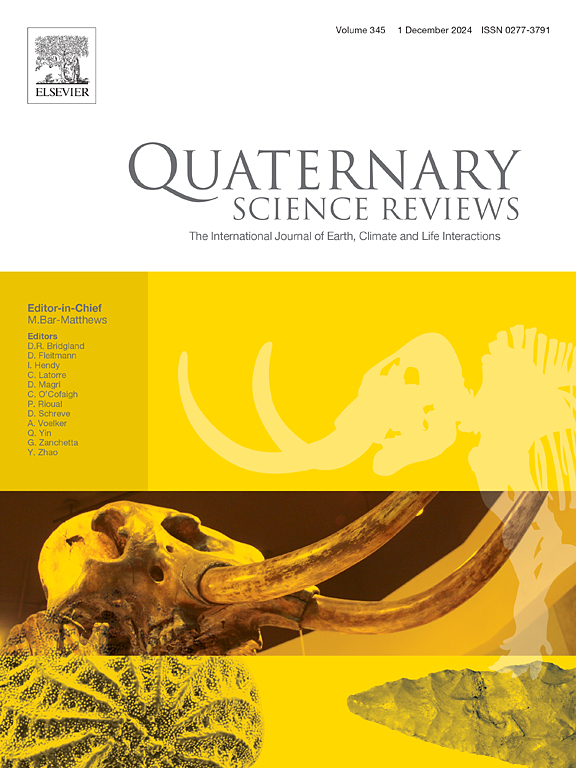Drivers of late Quaternary lake level fluctuations of Khyargas Nuur, western Mongolia - glacial meltwater discharge or atmospheric moisture supply?
IF 3.3
1区 地球科学
Q1 GEOGRAPHY, PHYSICAL
引用次数: 0
Abstract
This study presents the first comprehensive late Quaternary chronology of lake level variations of the Khyargas Nuur (western Mongolia), based on a geomorphological approach supported by luminescence dating of relict shorelines and lacustrine sediments. The endorheic Khyargas Nuur in the Basin of Great Lakes is the ultimate sink of a sequential water and sediment cascade from the adjacent Mongolian Altai and Khangai Mountains. Several intercalated lakes repeatedly joined as one major paleolake, as evidenced by various morphological shoreline features. Situated in the mid-latitude Westerlies-dominated climate regime of Arid Central Asia and affected by the distant effects of the East Asian Summer Monsoon, the dynamic climate of the Basin of Great Lakes is determined by the co-evolution of these atmospheric circulation systems. Our observations comprise 11 distinct paleolake levels between +7 m and +188 m above modern lake level (aml). Calculations of paleolake extent and water volume emphasize the periodically enhanced inflow and gradual capture and abandonment of upstream-located lakes. In the regional to global paleoclimatic context, our results reveal three distinct phases of lake level dynamics: (i) A transgression to a maximum level of +129 m aml during Marine Isotope Stage 5c (104.7 ± 14.4–88.8 ± 12.7 ka) primarily controlled by increased atmospheric moisture supply from the Westerlies. (ii) A post-Last Glacial Maximum lake expansion to a level of +118 m aml around 14 ka, ultimately controlled by enhanced glacial meltwater discharge into the basin. This is followed by a lake regression throughout the late Glacial to early Holocene transition in response to a gradually decreasing meltwater supply and a drier climate. (iii) A late Holocene transgression to +15 m aml reflecting a general Holocene wetting trend across arid Central Asia, followed by small-scale level fluctuations post 2.6 ka.
喀尔喀斯湖晚第四纪湖泊水位波动的驱动因素——冰川融水排放还是大气水分供应?
本研究首次以地貌方法为基础,结合残滨线和湖泊沉积物的发光测年,对蒙古西部喀尔嘎斯湖的湖泊水位变化进行了全面的晚第四纪年代学研究。大湖区内陆性的喀尔加斯盆地是相邻的蒙古阿尔泰山脉和康凯山脉连续水和沉积物级联的最终汇。几个间隔湖反复连接成一个主要的古湖泊,各种形态的海岸线特征证明了这一点。大湖区位于中亚干旱地区以西风为主的中纬度气候区,受东亚夏季风的远距离影响,大湖区的动力气候是由这些大气环流系统的共同演化决定的。我们的观测包括11个不同的古湖泊水位,在现代湖泊水位(aml)之上+7米至+188米之间。古湖泊范围和水量的计算强调周期性增加的流入和上游湖泊的逐渐捕获和放弃。在区域和全球古气候背景下,我们的研究结果揭示了湖泊水位动态的三个不同阶段:(i)海洋同位素阶段5c(104.7±14.4-88.8±12.7 ka)期间,海侵至+129 m aml的最大水位,主要受西风带大气水分供应增加的控制。(ii)末次冰期后湖泊在14ka左右最大扩张至+ 118m / l,最终受冰川融水向盆地排放的增加控制。随后,在整个冰期晚期到全新世早期的过渡时期,由于融水供应逐渐减少和气候变干,湖泊出现了回归。(iii)全新世晚期至+15 m的海侵,反映了整个中亚干旱地区的全新世总体湿润趋势,随后是2.6 ka后的小尺度水平面波动。
本文章由计算机程序翻译,如有差异,请以英文原文为准。
求助全文
约1分钟内获得全文
求助全文
来源期刊

Quaternary Science Reviews
地学-地球科学综合
CiteScore
7.50
自引率
15.00%
发文量
388
审稿时长
3 months
期刊介绍:
Quaternary Science Reviews caters for all aspects of Quaternary science, and includes, for example, geology, geomorphology, geography, archaeology, soil science, palaeobotany, palaeontology, palaeoclimatology and the full range of applicable dating methods. The dividing line between what constitutes the review paper and one which contains new original data is not easy to establish, so QSR also publishes papers with new data especially if these perform a review function. All the Quaternary sciences are changing rapidly and subject to re-evaluation as the pace of discovery quickens; thus the diverse but comprehensive role of Quaternary Science Reviews keeps readers abreast of the wider issues relating to new developments in the field.
 求助内容:
求助内容: 应助结果提醒方式:
应助结果提醒方式:


